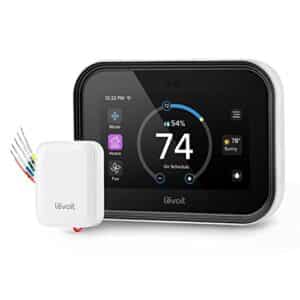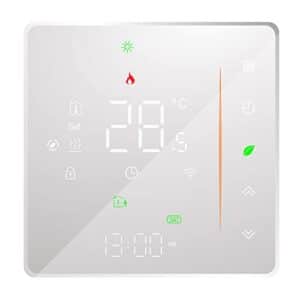How Do Smart Thermostats Save Energy?
Key Takeaways
- Smart thermostats offer convenience and control by learning temperature preferences, establishing energy-saving schedules, and allowing remote control via smartphone.
- Smart thermostats provide insight into energy usage patterns, helping users identify areas for further energy optimization. They can save customers 10-15% on HVAC costs and potentially up to 30%.
- Smart thermostats enter a low-power standby mode when inactive, saving energy. They also receive software updates to optimize energy efficiency and adapt to user behavior over time.
Smart thermostats are becoming increasingly popular for their ability to improve energy efficiency and reduce energy consumption in homes. By utilizing advanced technology and intelligent algorithms, these devices offer several features that optimize heating and cooling settings, resulting in significant energy savings. In this article, we will explore how smart thermostats save energy and the benefits they provide for homeowners.
1. Convenience and Control
One of the main advantages of smart thermostats is their convenience and control. These devices can learn your temperature preferences and establish a schedule that automatically adjusts to energy-saving temperatures when you are asleep or away. They can also use geofencing technology to detect when you’re on the way home and adjust the temperature accordingly.
Moreover, Wi-Fi enabled smart thermostats allow you to control your home’s heating and cooling remotely through your smartphone. This means you can adjust the temperature settings even when you’re not at home. For example, if you’re on vacation and realize you forgot to turn off your HVAC system, you can easily do so using the smart thermostat app on your phone.
2. Insight and Energy Savings
Smart thermostats provide valuable insight into your energy usage patterns and help you make adjustments to further optimize energy efficiency. They offer equipment use and temperature data that you can track and manage. By understanding how and when you use energy in your home, you can identify areas where you can reduce consumption and save on energy costs.
Independent studies have shown that smart thermostats can save customers 10-15% on HVAC costs. Some manufacturers even claim higher savings of up to 30%. These energy savings are achieved by controlling your home temperature and creating customized heating and cooling schedules. Smart thermostats ensure that your HVAC system only runs when needed, avoiding unnecessary energy consumption.
3. Standby Mode and Software Updates
Smart thermostats that earn the ENERGY STAR label have been independently certified to deliver energy savings. They are designed to enter a low-power standby mode when inactive, saving energy when not in use. This means that when you’re not actively controlling the thermostat, it will minimize power usage, contributing to overall energy efficiency.
Additionally, smart thermostats receive periodic software updates to ensure they are using the latest algorithms and energy-saving features available. These updates help optimize energy efficiency over time. By regularly updating the software, smart thermostats can continue to learn and adapt to your behavior patterns, further enhancing their energy-saving capabilities.
4. Comparison with Traditional Thermostats
Compared to traditional thermostats, smart thermostats offer significant advantages in terms of energy efficiency. Traditional thermostats require manual adjustments and do not have the ability to learn your behavior patterns or adjust temperature settings based on occupancy levels.
While the exact comparison of energy savings between smart thermostats and traditional thermostats is not provided in the given information, it is clear that smart thermostats have the potential to save more energy due to their advanced features and capabilities.
Related Websites:
FAQs:
Q: What is a smart thermostat and how can it benefit me?
A smart thermostat is a device that can connect to your home’s Wi-Fi network and allows you to control your home’s temperature remotely through mobile apps or voice assistants. By using learning algorithms, smart thermostats adapt to your preferences and schedule, optimizing temperature settings for energy conservation. With real-time energy monitoring, detailed reports, and the ability to create energy-saving schedules, smart thermostats can help you reduce energy consumption and save on utility bills.
Q: Can a smart thermostat help me track and monitor my energy usage?
Yes, smart thermostats can track and monitor your energy usage within your home. They provide detailed reports and insights on energy consumption patterns, allowing you to make informed decisions about your energy usage. With access to real-time energy data, you can identify areas where you can further conserve energy and reduce waste.
Q: How does geofencing work with smart thermostats?
Geofencing is a feature used in smart thermostats that detects your proximity to your home. Through geolocation technology, smart thermostats can adjust temperature settings based on whether you are at home or away. This energy-saving feature ensures that your heating or cooling system is not unnecessarily running when no one is home, helping you save on energy costs.
Q: Can a smart thermostat integrate with other smart home devices?
Yes, smart thermostats can integrate with other smart home devices. They are compatible with devices like occupancy sensors or smart vents, which further enhance energy efficiency. Automation and coordination between different smart devices can optimize your home’s energy consumption, ensuring that energy is only used when needed.
Q: What are some energy-saving tips when using a smart thermostat?
To maximize energy savings with a smart thermostat, consider the following tips: 1) Set temperature schedules that align with your daily routines and occupancy patterns. 2) Take advantage of personalized temperature settings to optimize comfort and energy usage. 3) Regularly maintain your smart thermostat and keep it up-to-date with firmware updates. 4) Explore additional resources and consult energy-saving guidelines specific to your region for more tailored recommendations.






